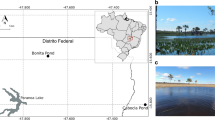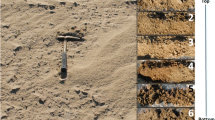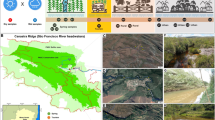Abstract
Re-naturalized quarry lakes are important ecosystems, which support complex communities of flora and fauna. Microorganisms associated with sediment and water form the lowest trophic level in these ecosystems and drive biogeochemical cycles. A direct comparison of microbial taxa in water and sediment microbial communities is lacking, which limits our understanding of the dominant functions that are carried out by the water and sediment microbial communities in quarry lakes. In this study, using the 16S rDNA amplicon sequencing approach, we compared microbial communities in the water and sediment in two re-naturalized quarry lakes in Singapore and elucidated putative functions of the sediment and water microbial communities in driving major biogeochemical processes. The richness and diversity of microbial communities in sediments of the quarry lakes were higher than those in the water. The composition of the microbial communities in the sediments from the two quarries was highly similar to one another, while those in the water differed greatly. Although the microbial communities of the sediment and water samples shared some common members, a large number of microbial taxa (at the phylum and genus levels) were prevalent either in sediment or water alone. Our results provide valuable insights into the prevalent biogeochemical processes carried out by water and sediment microbial communities in tropical granite quarry lakes, highlighting distinct microbial processes in water and sediment that contribute to the natural purification of the resident water.




Similar content being viewed by others
References
Allewalt JP, Bateson MM, Revsbech NP, Slack K, Ward DM (2006) Effect of temperature and light on growth of and photosynthesis by Synechococcus isolates typical of those predominating in the octopus spring microbial mat community of Yellowstone National Park. Appl Environ Microbiol 72:544–550
Anderson MJ (2006) Distance-based tests for homogeneity of multivariate dispersions. Biometrics 62:245–253
Anderson-Glenna MJ, Bakkestuen V, Clipson NJ (2008) Spatial and temporal variability in epilithic biofilm bacterial communities along an upland river gradient. FEMS Microbiol Ecol 64:407–418
Bai L, Cao C, Wang C, Xu H, Zhang H, Slaveykova VI, Jiang H (2017) Toward quantitative understanding of the bioavailability of dissolved organic matter in freshwater lake during Cyanobacteria blooming. Environ Sci Technol 51:6018–6026
Battin TJ, Besemer K, Bengtsson MM, Romani AM, Packmann AI (2016) The ecology and biogeochemistry of stream biofilms. Nat. Rev. Microbiol. 14:251–263
Benacer D, Woh PY, Zain SNM, Amran F, Thong KL (2013) Pathogenic and saprophytic Leptospira species in water and soils from selected urban sites in peninsular Malaysia. Microbes Environ. 28:135–140
Bicca FC, Fleck LC, Ayub MAZ (1999) Production of biosurfactant by hydrocarbon degrading Rhodococcus ruber and Rhodococcus erythropolis. Rev. Microbiol. 30:231–236
Bollmann A, Bullerjahn GS, McKay RM (2014) Abundance and diversity of ammonia-oxidizing archaea and bacteria in sediments of trophic end members of the Laurentian Great Lakes, Erie and Superior. PLoS One 9(5):e97068
Cámara B, De los Ríos A, Urizal M, De Buergo MÁ, Varas MJ, Fort R, Ascaso C (2011) Characterizing the microbial colonization of a dolostone quarry: implications for stone biodeterioration and response to biocide treatments. Microb Ecol 62:299–313
Capone DG, Bronk DA, Mulholland MR, Carpenter EJ (2008) Nitrogen in the marine environment. Academic Press, Cambridge
Chin K-J, Lukow T, Conrad R (1999) Effect of temperature on structure and function of the methanogenic archaeal community in an anoxic rice field soil. Appl Environ Microbiol 65:2341–2349
Clarke K (1993) Non-parametric multivariate analyses of changes in community structure. Aust J Ecol 18:117–143
Colwell RK, Chao A, Gotelli NJ, Lin S-Y, Mao CX, Chazdon RL, Longino JT (2012) Models and estimators linking individual-based and sample-based rarefaction, extrapolation and comparison of assemblages. J Plant Ecol 5:3–21
Corlett RT (1988) Bukit Timah: the history and significance of a small rain-forest reserve. Environ Conserv 15:37–44
Cotner JB, Biddanda BA (2002) Small players, large role: microbial influence on biogeochemical processes in pelagic aquatic ecosystems. Ecosystems 5:105–121
Dadheech PK, Glöckner G, Casper P, Kotut K, Mazzoni CJ, Mbedi S, Krienitz L (2013) Cyanobacterial diversity in the hot spring, pelagic and benthic habitats of a tropical soda lake. FEMS Microbiol Ecol 85:389–401
De Rezende JR, Kjeldsen KU, Hubert CR, Finster K, Loy A, Jørgensen BB (2013) Dispersal of thermophilic Desulfotomaculum endospores into Baltic Sea sediments over thousands of years. ISME J 7:72–84
Domaizon I, Savichtcheva O, Debroas D, Arnaud F, Villar C, Pignol C, Alric B, Perga ME (2013) DNA from lake sediments reveals the long-term dynamics and diversity of Synechococcus assemblages. Biogeosciences 10:3817–3838
Douterelo I, Jackson M, Solomon C, Boxall J (2016) Microbial analysis of in situ biofilm formation in drinking water distribution systems: implications for monitoring and control of drinking water quality. Appl Microbiol Biotechnol 100:3301–3311
Fang L, Chen L, Liu Y, Tao W, Zhang Z, Liu H, Tang Y (2015) Planktonic and sedimentary bacterial diversity of Lake Sayram in summer. Microbiologyopen 4:814–825
Feng B-W, Li X-R, Wang J-H, Hu Z-Y, Meng H, Xiang L-Y, Quan Z-X (2009) Bacterial diversity of water and sediment in the Changjiang estuary and coastal area of the East China Sea. FEMS Microbiol Ecol 70:236–248
Ferris FG, Fyfe W, Beveridge T (1987) Bacteria as nucleation sites for authigenic minerals in a metal-contaminated lake sediment. Chem Geol 63:225–232
Frenzel P, Thebrath B, Conrad R (1990) Oxidation of methane in the oxic surface layer of a deep lake sediment (Lake Constance). FEMS Microbiol Ecol 6:149–158
Gächter R, Meyer JS, Mares A (1988) Contribution of bacteria to release and fixation of phosphorus in lake sediments. Limnol Oceanogr 33:1542–1558
Garcia-Valles M, Urzì C, Vendrell-Saz M (2002) Weathering processes on the rock surface in natural outcrops: the case of an ancient marble quarry (Belevi, Turkey). Environ Geol 41:889–897
Glass EM, Wilkening J, Wilke A, Antonopoulos D, Meyer F (2010) Using the metagenomics RAST server (MG-RAST) for analyzing shotgun metagenomes. Cold Spring Harb Protoc. https://doi.org/10.1101/pdb.prot5368
Guezennec A-G, Michel C, Ozturk S, Togola A, Guzzo J, Desroche N (2015) Microbial aerobic and anaerobic degradation of acrylamide in sludge and water under environmental conditions—case study in a sand and gravel quarry. Environ Sci Pollut Res 22:6440–6451
Hamdi O, Hania WB, Postec A, Bouallagui H, Hamdi M, Bonin P, Ollivier B, Fardeau M-L (2015) Aminobacterium thunnarium sp. nov., a mesophilic, amino acid-degrading bacterium isolated from an anaerobic sludge digester, pertaining to the phylum Synergistetes. Int J Syst Evol Microbiol 65:609–614
Henderson JC (2000) The survival of a forest fragment: Bukit Timah Nature Reserve, Singapore. Forest tourism and recreation: case studies in environmental management. New York: Cabi Pub, pp 23–39
Henne K, Kahlisch L, Brettar I, Höfle MG (2012) Analysis of structure and composition of bacterial core communities in mature drinking water biofilms and bulk water of a citywide network in Germany. Appl Environ Microbiol 78:3530–3538
Hernandez-Eugenio G, Fardeau M-L, Cayol J-L, Patel BK, Thomas P, Macarie H, Garcia J-L, Ollivier B (2002) Sporanaerobacter acetigenes gen. nov., sp. nov., a novel acetogenic, facultatively sulfur-reducing bacterium. Int J Syst Evol Microbiol 52:1217–1223
Holmes DE, Nevin KP, Woodard TL, Peacock AD, Lovley DR (2007) Prolixibacter bellariivorans gen. nov., sp. nov., a sugar-fermenting, psychrotolerant anaerobe of the phylum Bacteroidetes, isolated from a marine-sediment fuel cell. Int J Syst Evol Microbiol 57(4):701–707
Iguchi A, Terada T, Narihiro T, Yamaguchi T, Kamagata Y, Sekiguchi Y (2009) In situ detection and quantification of uncultured members of the phylum Nitrospirae abundant in methanogenic wastewater treatment systems. Microbes Environ 24(2):97–104
Kerou M, Offre P, Valledor L, Abby SS, Melcher M, Nagler M, Weckwerth W, Schleper C (2016) Proteomics and comparative genomics of Nitrososphaera viennensis reveal the core genome and adaptations of archaeal ammonia oxidizers. Proc Natl Acad Sci 113:E7937–E7946
Kim D, Kim Y-S, Kim S-K, Kim SW, Zylstra GJ, Kim YM, Kim E (2002) Monocyclic aromatic hydrocarbon degradation by Rhodococcus sp. strain DK17. Appl Environ Microbiol 68:3270–3278
Klindworth A, Pruesse E, Schweer T, Peplies J, Quast C, Horn M, Glöckner FO (2013) Evaluation of general 16S ribosomal RNA gene PCR primers for classical and next-generation sequencing-based diversity studies. Nucleic Acids Res 41:e1–e1
Latour D, Sabido O, Salençon M-J, Giraudet H (2004) Dynamics and metabolic activity of the benthic cyanobacterium Microcystis aeruginosa in the Grangent reservoir (France). J Plankton Res 26:719–726
Lin C-C, San Yan CJ, Kan S-C, Hsueh N-C, Yang L-Y, Shieh C-J, Huang C-C, Liu Y-C (2017) Deciphering characteristics of the designer cellulosome from Bacillus subtilis WB800N via enzymatic analysis. Biochem Eng J 117:147–155
Liu B, Li Y, Zhang J, Zhou X, Wu C (2014) Abundance and diversity of ammonia-oxidizing microorganisms in the sediments of Jinshan Lake. Curr Microbiol 69(5):751–757
Louca S, Parfrey LW, Doebeli M (2016) Decoupling function and taxonomy in the global ocean microbiome. Science 353:1272–1277
Maki T, Nomachi M, Yoshida S, Ezawa T (2008) Plant symbiotic microorganisms in acid sulfate soil: significance in the growth of pioneer plants. Plant Soil 310:55–65
McMurdie PJ, Holmes S (2013) phyloseq: an R package for reproducible interactive analysis and graphics of microbiome census data. PLoS One 8:e61217
Mesbah NM, Abou-El-Ela SH, Wiegel J (2008) Novel and unexpected prokaryotic diversity in water and sediments of the alkaline, hypersaline lakes of the Wadi An Natrun, Egypt. Microb Ecol 55:369–369
Murtagh F, Legendre P (2014) Ward’s hierarchical agglomerative clustering method: which algorithms implement ward’s criterion? J Classif 31:274–295
Newton RJ, Jones SE, Eiler A, McMahon KD, Bertilsson S (2011) A guide to the natural history of freshwater lake bacteria. Microbiol Mol Biol Rev 75:14–49
Ng DHP, Kumar A, Cao B (2016) Microorganisms meet solid minerals: interactions and biotechnological applications. Appl Microbiol Biotechnol 100:6935–6946
Nshimyimana JP, Freedman AJ, Shanahan P, Chua LC, Thompson JR (2017) Variation of bacterial communities with water quality in an urban tropical catchment. Environ Sci Technol 51(10):5591–5601
O’Sullivan LA, Weightman AJ, Fry JC (2002) New degenerate Cytophaga-Flexibacter-Bacteroides-specific 16S ribosomal DNA-targeted oligonucleotide probes reveal high bacterial diversity in River Taff epilithon. Appl Environ Microbiol 68:201–210
Oksanen J, Blanchet F, Kindt R, Legendre P, O’Hara R (2016) Vegan: community ecology package. R Packag. 2.3-3
O’sullivan LA, Roussel EG, Weightman AJ, Webster G, Hubert CR, Bell E, Head I, Sass H, Parkes RJ (2015) Survival of Desulfotomaculum spores from estuarine sediments after serial autoclaving and high-temperature exposure. ISME J 9:922–933
Otwell AE, Callister SJ, Zink EM, Smith RD & Richardson RE (2016) Comparative proteomic analysis of Desulfotomaculum reducens MI-1: insights into the metabolic versatility of a gram-positive sulfate- and metal-reducing bacterium. Front Microbiol 7:191
Qu J, Zhang Q, Zhang N, Shen L, Liu P (2015) Microbial community diversity in water and sediment of an eutrophic lake during harmful algal bloom using MiSeq illumina technology. Int Congr Adv Environ Res. https://doi.org/10.7763/IPCBEE
Rotaru A-E, Shrestha PM, Liu F, Markovaite B, Chen S, Nevin KP, Lovley DR (2014) Direct interspecies electron transfer between Geobacter metallireducens and Methanosarcina barkeri. Appl. Environ Microbiol 80:4599–4605
Rothfuss F, Bender M, Conrad R (1997) Survival and activity of bacteria in a deep, aged lake sediment (Lake Constance). Microb Ecol 33:69–77
Savage DF, Afonso B, Chen AH, Silver PA (2010) Spatially ordered dynamics of the bacterial carbon fixation machinery. Science 327:1258–1261
Schramm A, De Beer D, Gieseke A, Amann R (2000) Microenvironments and distribution of nitrifying bacteria in a membrane-bound biofilm. Environ Microbiol 2(6):680–686
Seitzinger S, Nixon S (1987) Eutrophication and the rate of denitrification and N2O production in nearshore marine sediments. Limnol Oceanogr 30:1332–1339
Smith JA, Tremblay P-L, Shrestha PM, Snoeyenbos-West OL, Franks AE, Nevin KP, Lovley DR (2014) Going wireless: Fe (III) oxide reduction without pili by Geobacter sulfurreducens strain JS-1. Appl Environ Microbiol 80:4331–4340
Sørensen J, Jørgensen BB, Revsbech NP (1979) A comparison of oxygen, nitrate, and sulfate respiration in coastal marine sediments. Microb Ecol 5:105–115
Stal LJ, Severin I, Bolhuis H (2010) The ecology of nitrogen fixation in cyanobacterial mats. In: Hallenbeck PC (ed) Recent advances in phototrophic prokaryotes. Springer, Berlin/Heidelberg, pp 31–45
Stieglmeier M, Klingl A, Alves RJ, Simon KM, Melcher M, Leisch N, Schleper C (2014) Nitrososphaera viennensis gen. nov., sp. nov., an aerobic and mesophilic, ammonia-oxidizing archaeon from soil and a member of the archaeal phylum Thaumarchaeota. Int J Syst Evol Microbiol 64(8):2738–2752
Tsujimura S, Okubo T (2003) Development of Anabaena blooms in a small reservoir with dense sediment akinete population, with special reference to temperature and irradiance. J Plankton Res 25:1059–1067
Urzí C, Realini M (1998) Colour changes of Notos calcareous sandstone as related to its colonisation by microorganisms. Int Biodeterior Biodegrad 42:45–54
Ward Jr JH (1963) Hierarchical grouping to optimize an objective function. J. Am. Stat. Assoc. 58:236–244
Wilke A, Gerlach W, Harrison T, Paczian T, Trimble WL, Meyer F (2016) MG-RAST Manual for version 4, revision
Wrótniak-Drzewiecka W, Brzezińska AJ, Dahm H, Ingle AP, Rai M (2016) Current trends in myxobacteria research. Ann Microbiol 66:17–33
Xie G, Bruce DC, Challacombe JF, Chertkov O, Detter JC, Gilna P, Han CS, Lucas S, Misra M, Myers GL (2007) Genome sequence of the cellulolytic gliding bacterium Cytophaga hutchinsonii. Appl Environ Microbiol 73:3536–3546
Zapala MA, Schork NJ (2006) Multivariate regression analysis of distance matrices for testing associations between gene expression patterns and related variables. Proc Natl Acad Sci 103:19430–19435
Keegan KP, Glass EM, Meyer F (2016) MG-RAST, a metagenomics service for analysis of microbial community structure and function. In: Martin F, Uroz S (eds) Microbial environmental genomics. Springer, Berlin/Heidelberg, pp 207–233
Shcherbakova VA, Laurinavichyus KS, Chuvil’skaya NA, Ryzhmanova YV, Akimenko VK (2015) Anaerobic bacteria involved in the degradation of aromatic sulfonates to methane. Appl Biochem Microbiol 51(2):209–214
Liu G, Ling FQ, van der Mark EJ, Zhang XD, Knezev A, Verberk JQJC, van der Meer WGJ, Medema GJ, Liu WT, van Dijk JC (2016) Comparison of particle-associated bacteria from a drinking water treatment plant and distribution reservoirs with different water sources. Sci Rep 6:20367
Acknowledgements
Sequencing was carried out with the help of Dr. Daniela Moses and Professor Stephan Schuster using the sequencing facilities at the Singapore Centre for Environmental Life Sciences Engineering (SCELSE), Nanyang Technological University, Singapore. We thank the Singapore National Parks Board (NParks), in particular, Ms. Samantha Lai and Ms. Joanna Yeo, for their assistance in sample collection. This material is based on research/work supported by the Singapore Ministry of National Development and National Research Foundation under L2 NIC Award No. L2NICCFP1-2013-3.
Author information
Authors and Affiliations
Corresponding author
Ethics declarations
Competing Interests
The authors declare that they have no competing interests.
Disclaimer
Any opinions, findings, and conclusions or recommendations expressed in this material are those of the authors and do not necessarily reflect the views of the L2 NIC.
Electronic Supplementary Material
ESM 1
(PDF 3659 kb)
Rights and permissions
About this article
Cite this article
Kumar, A., Ng, D.H.P., Wu, Y. et al. Microbial Community Composition and Putative Biogeochemical Functions in the Sediment and Water of Tropical Granite Quarry Lakes. Microb Ecol 77, 1–11 (2019). https://doi.org/10.1007/s00248-018-1204-2
Received:
Accepted:
Published:
Issue Date:
DOI: https://doi.org/10.1007/s00248-018-1204-2




